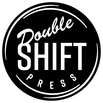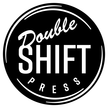Between us, Jess and I have named four cats, five children, two dissertations, assorted books, and a business. What have we learned? Sometimes a name is instantly, exactly right…and sometimes it takes a little time to grow into.
Double Shift Press…it took a little time.
Actually, we researched, registered, and sketched a whole webpage around a totally different name. But that name wasn’t perfect, so we decided to let it go. When we went back to our list of possibilities, Double Shift Press had already started feeling exactly right.
Double Shift is our second shift, after all. But it’s not a side hustle—it’s a concentration and an expansion of what we already do at Modern Writing Services.
Double Shift Press…it took a little time.
Actually, we researched, registered, and sketched a whole webpage around a totally different name. But that name wasn’t perfect, so we decided to let it go. When we went back to our list of possibilities, Double Shift Press had already started feeling exactly right.
Double Shift is our second shift, after all. But it’s not a side hustle—it’s a concentration and an expansion of what we already do at Modern Writing Services.
Double Shift is our clients’ second shift, too. Developing, writing, designing, and publishing a book is a lot of (very worthwhile) work. Perhaps even more so for women, who are already—as Arlie Hochschild wrote way back in 1989 in The Second Shift—uniquely accustomed to this reality.
But Double Shift is about way more than work, even very worthwhile work. It’s about the—quite literal—expansion of possibilities.
Did you know that in the late 1800s, a “double shift key machine” described a category of typewriter with two shift keys? Adding a second shift key to the keyboard enabled each key to denote three characters instead of just one or even two.
Double Shift is our clients’ second shift, too. Developing, writing, designing, and publishing a book is a lot of (very worthwhile) work. Perhaps even more so for women, who are already—as Arlie Hochschild wrote way back in 1989 in The Second Shift—uniquely accustomed to this reality.
But Double Shift is about way more than work, even very worthwhile work. It’s about the—quite literal—expansion of possibilities.
Did you know that in the late 1800s, a “double shift key machine” described a category of typewriter with two shift keys? Adding a second shift key to the keyboard enabled each key to denote three characters instead of just one or even two.
So Double Shift Press also speaks to the value of collaboration, and to the way that collaboration can make a good book exponentially better (for authors and readers).
We’re excited to share news about our inaugural titles—stay tuned!



